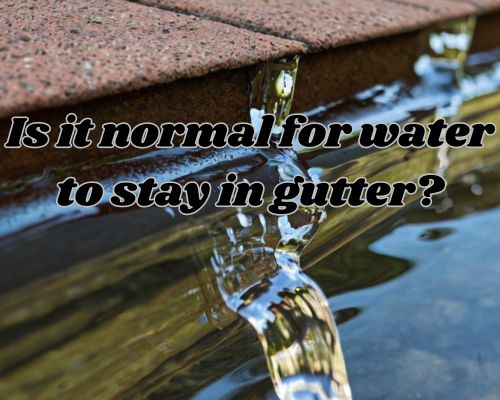When considering the health of your home’s gutters, understanding how they interact with rainwater is crucial.
Gutters are designed to channel rainwater away from the roof and foundation to prevent damage. Yet, a small amount of standing water in gutters following a storm is not unusual and often not a significant cause for concern.

A slight presence of water, usually up to around 2mm, can be typical and does not necessarily indicate a problem with your gutter system.
The issue arises when water doesn’t drain efficiently, leading to pooling that can have several adverse effects.
If left unresolved, stagnant water can attract pests and lead to potential damage to your home’s structure. Birds and insects, such as mosquitoes, might see these water pools as breeding grounds, which can become a nuisance.
To keep your gutters functioning properly, regular maintenance is essential.
Ensuring water flows smoothly through your drainage system protects your home from pest infestations and structural issues.
“By keeping an eye on how your gutters handle rainwater, you can secure your home’s health and your peace of mind.” said Steve Arnie of Gutter Cleaning Melbourne.
Understanding Gutter Performance and Maintenance
Proper gutter performance is essential for managing water effectively and ensuring the structural integrity of your home.
Regular maintenance helps prevent problems like blockages and standing water, reducing the risk of damage.
The Role of Gutters in Water Management
Gutters are crucial in directing water away from your home, preventing foundation damage, roof leaks, and erosion around your property.
A well-functioning gutter system collects rainwater and channels it safely to the ground.
Without effective water management, your home is vulnerable to several issues.
Rain gutters help in reducing the risk of water damage by preventing excess water from seeping into walls and basements.
Consequences of Standing Water in Gutters
Standing water in gutters can lead to serious issues, such as clogged gutters and structural damage.
When gutters fail to drain properly, they become a breeding ground for mould and mildew growth.
Furthermore, stagnant water can overflow and damage roofing materials, increasing the potential for leaks and rot.
Excess water can also cause the gutters to sag or detach from the home. This can lead to costly repairs if not addressed promptly, impacting the gutter system’s overall efficiency.
Preventing and Addressing Common Issues
Regular gutter maintenance is key to preventing blockages and maintaining efficient water flow.
Cleaning gutters at least twice a year removes debris such as leaves and twigs, which can obstruct water flow.
Inspect and repair any damage to ensure gutters are securely attached to your home.
Installing gutter guards can minimise debris accumulation and make cleaning easier.
Ensure gutters are correctly pitched toward downspouts for optimal drainage.
Regular inspections can identify potential problems, allowing for timely gutter repair and adjustments to prevent further damage.
Optimising Gutter Functionality
Ensuring that your gutter system is functioning optimally protects not only the structure but also the longevity of your home.
Key factors like proper installation, the right enhancements, and effective drainage management play a critical role in maintaining efficiency and preventing damage.
Criteria for Proper Gutter Installation
Proper installation is crucial for optimal gutter functionality.
It involves ensuring that gutters are securely attached and have the appropriate pitch.
The ideal slope for effective drainage is about 5 to 10 millimetres per 3 metres of gutter. This prevents sagging gutters that can lead to water accumulation and potential wood rot.
Attention to detail during installation avoids improper slopes that cause water to pool and become stagnant.
Secure fixtures prevent pests and insect infestations by eliminating unwanted water collection and debris build-up.
Working with professionals LIKE Steve Arnie of Gutter Cleaning Melbourne ensures high standards and long-lasting performance.
Enhancements with Gutter Guards
Installing gutter guards can significantly enhance your gutter system.
These guards prevent leaves and debris from clogging the gutters, ensuring uninterrupted water flow.
They also reduce the risk of pest infestations by blocking entry points for insects and small animals.
Various types of gutter guards are available, including mesh, reverse curve, and bottle brush styles.
Each type offers different benefits, so it’s important to choose one that suits your specific needs and climate.
More importantly, they can lessen the frequency of gutter cleaning, saving you time and reducing maintenance efforts.
Managing Water Flow and Drainage
Managing water flow is essential for optimal gutter functionality.
Proper downspout placement ensures effective drainage. It directs water safely away from your home’s foundation, preventing issues such as basement flooding and soil erosion around your property.
Regular inspections can help identify and correct inadequate slopes or blockages that hinder proper drainage.
They help avoid potential water damage.
Employing strategies like extending downspouts, incorporating splash blocks, or setting up rain barrels can further enhance water management.
Regular maintenance is essential to keep your system running smoothly. This includes cleaning and monitoring for any signs of inefficiency.